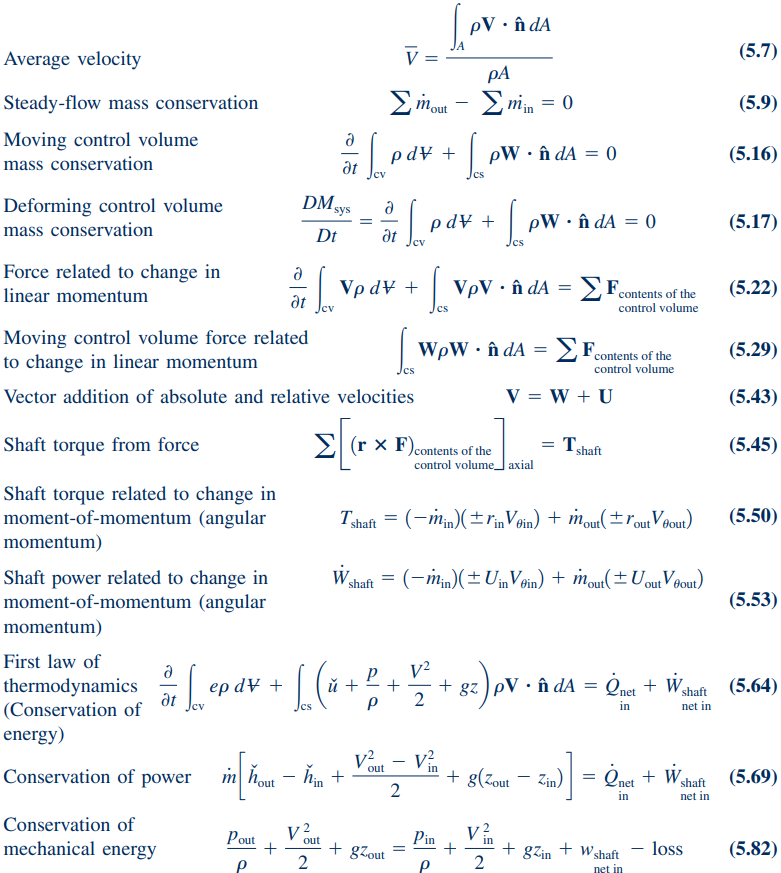NUCL350 Exam 2 Review (Chapters 4 & 5)
Chapter 4 - Fluid Kinematics
Key concepts highlighted by Bindra:
Eulerian and Lagrangian methods
velocity fields
acceleration fields
Reynolds transport theorem
Chapter Summary and Study Guide from textbook:
Definitions:
Field representation: Describes how a physical quantity, such as velocity or pressure, varies over space and time.
Velocity field: A vector field that shows the velocity of a fluid at every point in space and time.
Eulerian method: Observes fluid flow at fixed points in space as the fluid moves through them.
Lagrangian method: Tracks individual fluid particles as they move through space and time.
One-, two-, and three-dimensional flow: Describes fluid flow constrained to one, two, or three spatial dimensions, respectively.
Steady flow: Flow where fluid properties at any point do not change with time.
Unsteady flow: Flow where fluid properties vary with time at any point.
Streamline: A curve that is tangent to the velocity vectors of the flow at every point, showing the direction of the flow.
Streakline: A line that represents the locus of all fluid particles that have passed through a particular point in space.
Pathline: The actual path followed by an individual fluid particle over time.
Acceleration field: A vector field representing the acceleration of fluid particles at every point in space and time.
Material derivative: The rate of change of a fluid property (such as velocity) as observed from a moving fluid particle.
Local acceleration: The change in velocity at a fixed point in space over time.
Convective acceleration: The change in velocity of a fluid particle due to its movement through a velocity gradient in space.
System: A collection of fluid particles that is observed as it moves through space.
Control volume: A fixed region in space through which fluid may flow in and out, used for analyzing fluid systems.
Reynolds transport theorem: A fundamental equation that relates the rate of change of a property in a control volume to the flux of that property across its boundaries.
Equations

Chapter 5 - Finite Control Volume Analysis
Key concepts highlighted by Bindra:
mass conservation
linear and angular momentum conservation
energy conservation
be able to use Reynolds transport theorem in conservation problems
be able to do linear momentum balance be able to do control volume problems
important: be able to get to relative velocity
Chapter Summary and Study Guide from textbook:
Definitions:
Conservation of mass: The principle that mass cannot be created or destroyed in a closed system.
Continuity equation: A mathematical expression of conservation of mass in fluid flow, stating that the mass flow rate is constant along a streamline.
Mass flow rate: The amount of mass passing through a given area per unit time.
Linear momentum equation: Describes how the momentum of a fluid changes due to forces acting on it.
Moment-of-momentum equation: Relates the angular momentum of a fluid to the torques acting on it.
Shaft power: The mechanical power transmitted through a rotating shaft, typically in turbines or engines.
Shaft torque: The twisting force exerted by a shaft, related to its rotational motion.
First law of thermodynamics: States that energy cannot be created or destroyed, only transferred or converted from one form to another.
Heat transfer rate: The amount of thermal energy transferred per unit time.
Energy equation: Describes the conservation of energy in a fluid system, accounting for internal, kinetic, and potential energies.
Loss: The dissipation of energy in a system, typically due to friction or inefficiencies.
Shaft work head: The energy per unit weight of fluid associated with shaft work in a mechanical system.
Head loss: The reduction in fluid's energy or head due to friction, turbulence, or obstructions in a flow system.
Kinetic energy coefficient: A factor that accounts for variations in velocity across a flow area when calculating kinetic energy.
Equations:

